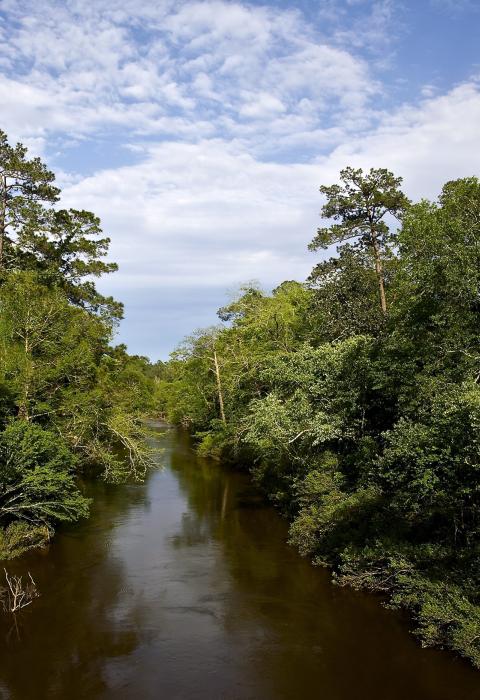Black Creek
Mississippi
This scenic southern river features deep, black water, colorful vertical bluffs and contrasting white sand bars as it follows a meandering course through Mississippi's coastal plain. Plants flourish and wildlife abounds. Trees and flowering shrubs overhang the banks. Wood ducks and otters are often seen by those visiting the stream. The river and area provide a variety of opportunities for backpacking and fishing and six launch points provide for canoeing. Primitive camping is allowed all along the stream within the national forest, and a number of trails can be accessed near the river.
Designated Reach
October 26, 1986. The segment from Fairley Bridge Landing upstream to Moody's Landing.
Outstandingly Remarkable Values
Fish
The Black Creek watershed and the designated river segment contains a diverse aquatic community, containing native fish and macroinvertebrates of management concern. In general, the river segment provides spawning, rearing, and/or migratory habitats for many of these freshwater species. The river supports high freshwater fish biodiversity and provides habitat for the federally threatened pearl darter (Percina aurora) and possibly the federally threatened gulf sturgeon (Acipenser oxyrinchus desotoi). An additional 130 fish species have been detected in the Black Creek watershed.
History
Black Creek has served as a home, mode of travel, and source of food and other resources to different populations in the area. From as early as 11,000 years ago, groups lived on the side tributaries, both large and small. For thousands of years, people moved up the side drainages and lived closer to the spring-fed headwaters and away from the banks of Black Creek. With the exploration of Europeans and the waves of settlers, this pattern remained. The Federal Road, which actually started in western Georgia, served as a means to deliver mail to far off places, a military travel route, and a road to greener pastures for settlers. A contingent of troops crossed on their way to New Orleans for the battle that ended the War of 1812. After the Civil War, the timber industry jump-started landscape logging activities along major drainages in the south as a means of transportation, and Black Creek was used as a highway for rafting logs down to mills on the coast.
Recreation
The primary recreational uses of the 21-mile Black Creek include fishing, hiking, hunting, swimming, camping, and floating. There are four main landings with a boat ramp, campsites, and toilets. The river can be accessed year-long, but summer is the busiest time, with most use during the weekend. Most visitors take day trips during the summer and two-day trips during the winter when campfires are allowed. Many visitors come from Louisiana, as there are not any rivers like Black Creek in the area that can offer a peaceful or solitude experience. Other rivers tend to be more swamp-like or brackish.
Scenery
The river is narrow with very little development. The banks gradually heighten, and the creek winds through a series of wide, deep curves, and narrow bends. This creates suspense and anticipation of observing scenic beauty just around the bend. Moss-covered banks and colorful vertical bluffs add to the picturesque setting.
Managing Partners And Contacts
Documents
Classification/Mileage
Video
A scenic video on the beauty and peace of Black Creek Wilderness, De Soto National Forest, Mississippi. In 1986, Congress included Black Creek in the National Wild and Scenic Rivers System, making it the first and only wild and scenic river in Mississippi. The De Soto National Forest is currently writing a plan about how Black Creek will be managed to protect and enhance its special features.

